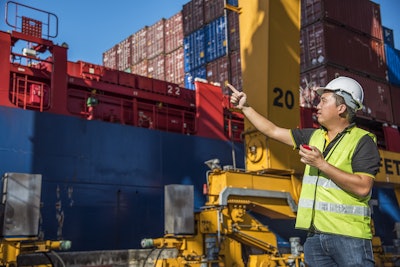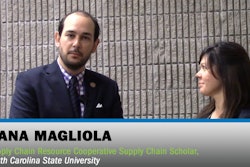
Food and beverage shippers involved in export trade are being required to provide verified container weight information under an International Maritime Organization (IMO) rule that took effect July 1. The full impact of the rule, known as the International Convention for the Safety of Life at Sea (SOLAS), was uncertain at the time of this report, as the U.S. maritime industry was working on a system to meet the requirements.
IMO amended its regulations to require that a container’s gross weight be verified before being loading onto a ship. The IMO previously required shippers to provide gross cargo mass on containers. IMO enacted the revision to address concerns about the safety of containers with inaccurate declared weights.
The amendment places the responsibility for providing a verified container weight on the shipper. Shippers are not only responsible for reporting the normal gross cargo weight, but also for certifying the verified gross mass (VGM) of each container. This includes the container weight provided by a carrier before the cargo being loaded on the ship.
The rule allows two methods for establishing a verified container weight:
Method 1: Once a container has been packed and sealed (using calibrated and certified equipment), the shipper has to weigh the container or arrange for a third party to weigh it.
Method 2: The shipper, or a third party, can weigh the package and cargo, including the mass of pallets and packing material to be packed in the container, and add the tare mass of the container to the sum of the container’s contents. The tare mass must be visible on the exterior of the container. Estimation of weights is not permitted. The shipper cannot rely on the weight provided by another party unless the weight is clearly and permanently marked on the container.
Shippers choosing the second method must comply with requirements established by countries where the container is packed and sealed. The IMO considers Method 2 as inappropriate for bulk cargo such as unbagged grain that do not lend themselves to individual weighing.
Electronic Form Encouraged
Shippers can communicate the verified gross mass (VGM) in a document, preferably in electronic form. The certificate must be signed by someone authorized by the shipper.
Because the contract of carriage is between the shipper and the carrier, not between the shipper and the port terminal facility, the shipper can meet its obligation by submitting the VGM to the carrier. It then becomes the carrier’s responsibility to provide the VGM to the terminal representative before loading. The carrier can also submit the VGM to the port terminal upon delivery of the container to the port before loading.
Containers exceeding the maximum permitted weight cannot be loaded onto a ship. The ship’s master decides whether a container can load.
Terminal operators and carriers need to establish processes for handling packed containers presented for loading that do not have a verified gross weight. Communication and preparation will be key to avoiding disruptions once the new rules are in effect.
A Learning Process
“There are lots of details that are not quite clear, but IMO basically has given a very clear signal of how this is to be done,” says Arne Martinsen, a shipping and transportation consultant to the Global Cold Chain Alliance (GCCA) and a member of the World Food Logistics Organization board of governors. “Everybody will know what the rules are by the time they get started working on it,” he says.
The IMO has encouraged a three-month grace period on the rule due to the confusion and lack of consistency of interpretation by enforcement authorities.
Disruptions Minor So Far
There were not a lot of delays when the July 1 deadline passed. However, there was confusion among shippers over which terminals were providing weighing services.
Some shippers complained that carriers were adding new charges. There were also reports of carriers rejecting cargo on account of the VGM weights not being provided, although these reports were not extensive.
The Global Shippers Forum (GSF) noted in early July that some of its members, mainly in Asia and Africa, reported some carriers and service providers were exploiting the VGM rules by imposing charges for unspecified administration fees and services. The GSF has called for those charges to be withdrawn.
“It’s going to take some time for this to settle out,” says Bryn Heimbeck, president of Trade Tech Inc., a cloud-based logistics software provider that facilitates VGM data delivery. Some terminals are providing the weighing while others are not. He says there is a heightened sense of urgency among shippers. “On a global level, some cargo’s been turned away. Some carriers are saying, ‘we’re not going to worry about it for now.’ It’s truly a hodgepodge.”
Heimbeck says the flow of maritime information is disjointed to begin with. The VGM rule is creating a demand for a level of visibility that does not currently exist in the industry. The rule will push multiple parties to collaborate. “There’s been limited guidance from our government on what the actual requirements would be,” he notes.
The Ocean Carrier Equipment Management Association (OCEMA), which represents the majority of the ocean carriers in the United States, applauded the efforts of the ports and marine terminal operators that have announced they will provide VGM weighing services on behalf of U.S. exporters.
OCEMA has encouraged U.S. terminal operators to weigh containers moving through their truck gates and provide the gross container weights directly to ocean carrier stowage planners. Shippers availing themselves of this option would not be required to provide a signature to the ocean carrier for each container, but would acknowledge that the use of on-terminal scaling provides a VGM, OCEMA notes.
The U.S. Coast Guard, which enforces maritime regulations in the United States, has noted that the processes used by terminals to obtain gross container weights are compliant with the SOLAS mandate.
In cases where the terminal weighing approach is not feasible, OCEMA has indicated it will continue to evaluate ways to achieve VGM compliance.
The following facilities will accept and weigh full containers and provide shippers and carriers with the VGM data, according to GCCA: Port Newark Container Terminal, Seagirt Marine Terminal (Baltimore, Md.), Port of Virginia, Port of Charleston, Port of Savannah, Port Everglades and Port of Miami.
Cold Storage Operators Impacted
Cold storage operators will likely to be requested to provide VGM data for containers at completion of packing, the GCCA noted in a guidance document on SOLAS. In such cases, the cold storage client will be the named shipper on the ocean bill of lading. The client’s shipping manager or other authorized staff will sign the VGM based on the weight data received from the operator.
Cold storage operators involved in the loading, shipping or transporting of marine containers have been working with shippers, carriers and terminals to determine strategies for meeting the requirements.
The GCCA guidance document notes the following companies are developing software to facilitate digital delivery of VGM data:
• INTTRA, an ocean shipping e-marketplace, seeks to make the digital delivery of the VGM of a container as simple and straightforward as possible.
• Trade Tech Inc., a provider of transportation management and supply chain solutions, has a product name SYRINX, an e-Shipping Portal.
• Kewill Inc., a freight forwarder and provider of supply chain software, has developed freight forwarding software for the SOLAS container weight verification requirement in partnership with INTTRA.
• Mobileweight LLC, a global container shipping solutions provider, has developed a solution for the electronic VGM filing with ocean carriers.
One area of uncertainty is the “cutoff time” for the delivery of the containers to the terminal with the weight information ready.
Shippers may need to build extra time into their supply chains in order to submit the VGM details so that stowage planning can be completed before loading.
The GCCA guidance document includes information on the positions on VGM of various international ports outside of the United States.
Out of the 162 nations that are signatories to IMO, only 23 had issued the required guidance and regulations to exporters, port terminals and international shipping companies by midsummer.
Vincent Clerc, chief commercial officer for Maersk Line, expects a “bumpy” six-month period.
“We are committed to making the process as easy as possible–but we also anticipate the next six months to be bumpy,” Clerk wrote on LinkedIn in mid-June. “As we have been preparing for implementation of VGM, it has been clear that coordination and alignment on a global level–with hundreds of jurisdictions with very different shipping and trade tradition–have to improve.”
Maersk has recommended three steps to its customers: 1) Provide VGM at the time of creating your shipping instructions, 2) Submit the VGM electronically to avoid manual mistakes, and 3) Submit the VGM free of charge on the Maersk website.
Mediterranean Shipping Company (MSC) has instructed shippers to include the following items on VGM instructions: booking of bill of lading number, container number, the VGM in the weight measurement unit (lbs. or kgs.), the responsible party’s name and a digital signature of the authorized signatory. (MIQ Logistics, a 3PL, has posted the MSC requirements.)
MSC requires shippers to send VGM instructions to its website via EDI using INTRRA, GT Nexus or CargoSmart Ltd., or manually via fax or email. Manual VGM submission fee is $25 per container, with an additional $25 late fee per container. There is also a $300 fee per misdeclaration per container.
The Agriculture Transportation Coalition, which represents agriculture exporters, notes there is still work to be done, particularly for containers arriving at terminals without going through the gates by on-dock rail.
Tyson Fresh Meats Claims VGM Rule will Cause Delays
Perry Bourne, director of international transportation and rail operations for Tyson Fresh Meats, told a U.S. Senate Committee in April the verified gross mass (VGM) rule will cause delays. Bourne testified before the Senate Committee on Commerce, Science and Transportation Subcommittee on Surface Transportation and Merchant Marine Infrastructure, Safety and Security on behalf of the Agriculture Transportation Coalition.
Bourne stated that the weight of the container assigned to Tyson’s booking is not known at the time of loading. If Tyson is unable to obtain the container weight for the VGM until the time of transloading, any cargo transloaded late would have to be delayed for the following week’s sailing and Tyson would have to air freight the cargo or convert a chilled fresh product to a frozen product.




















